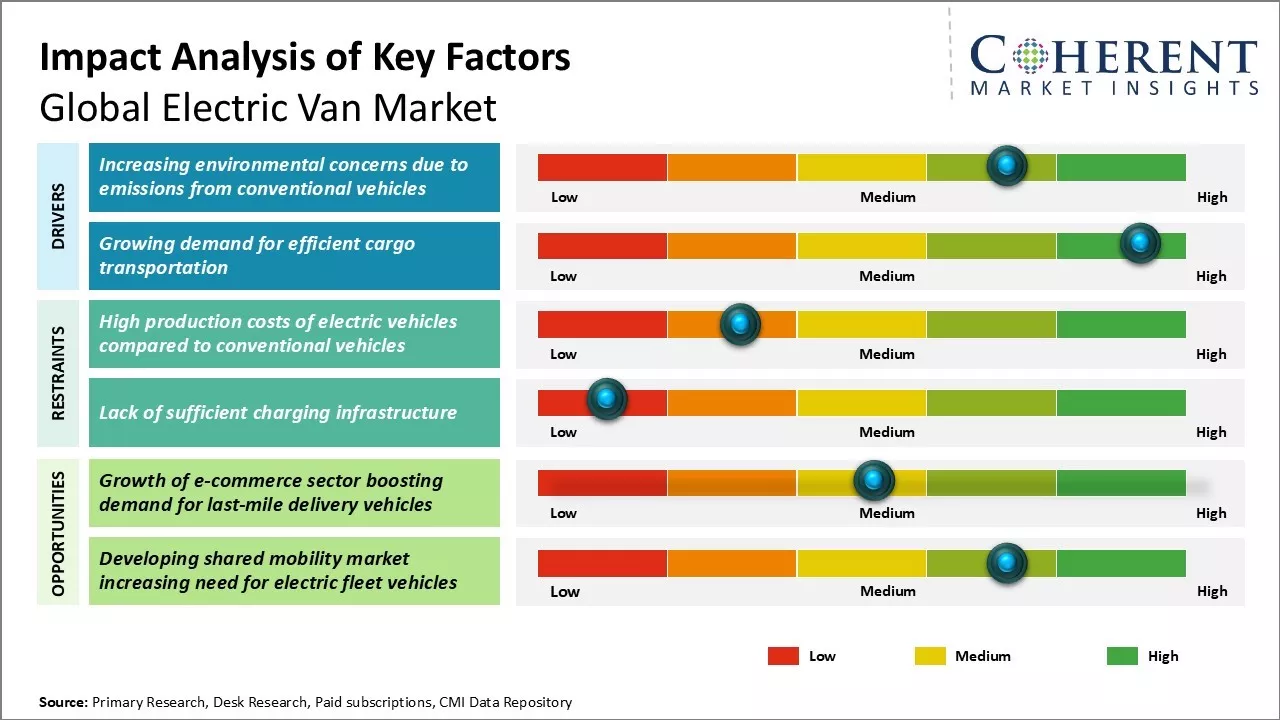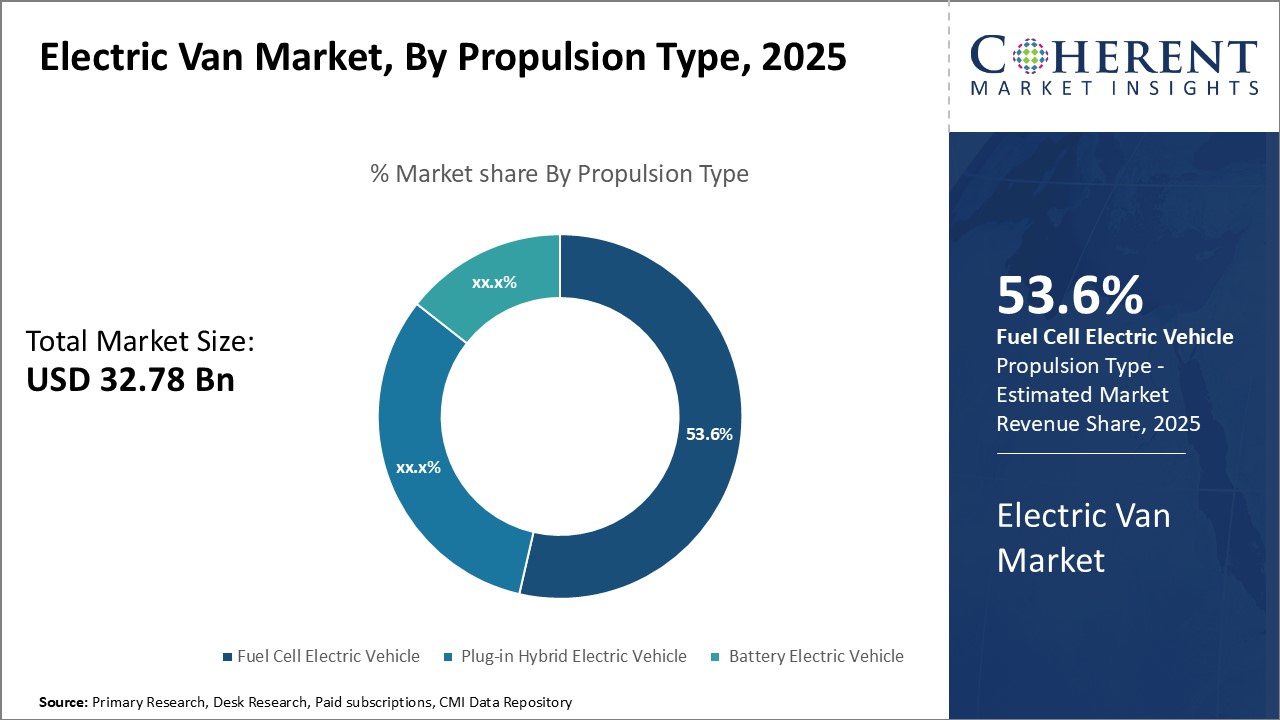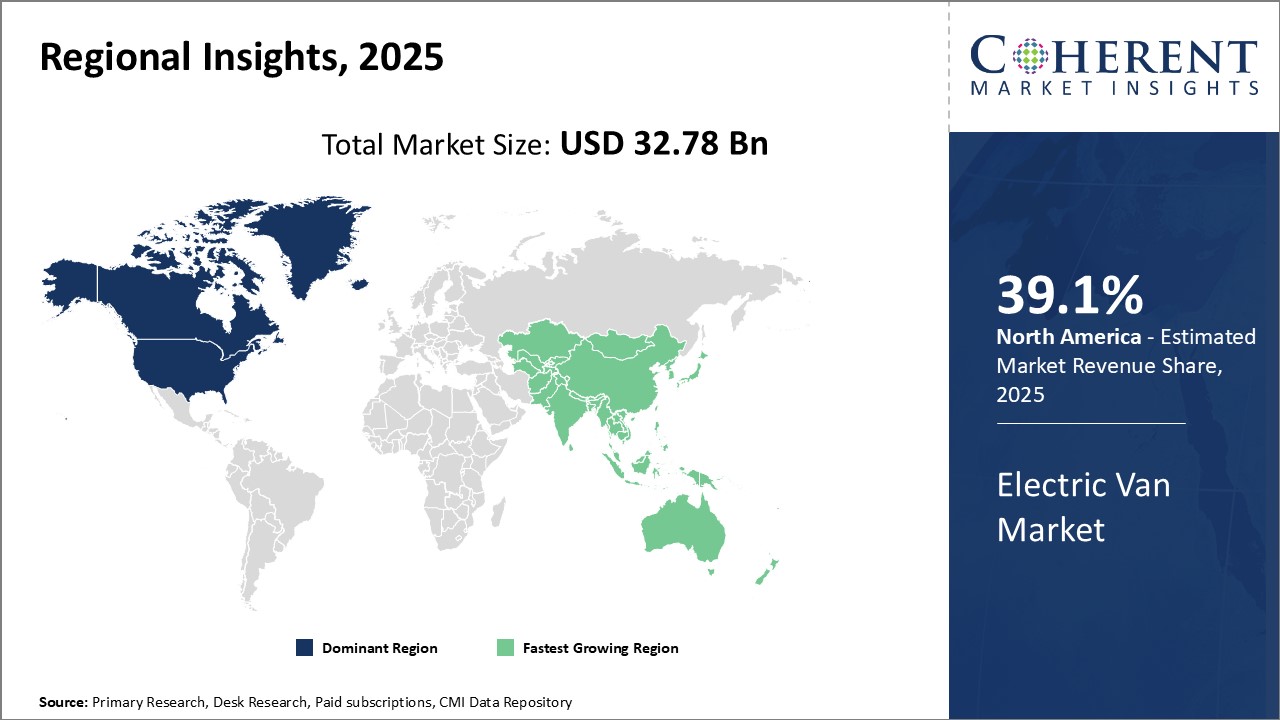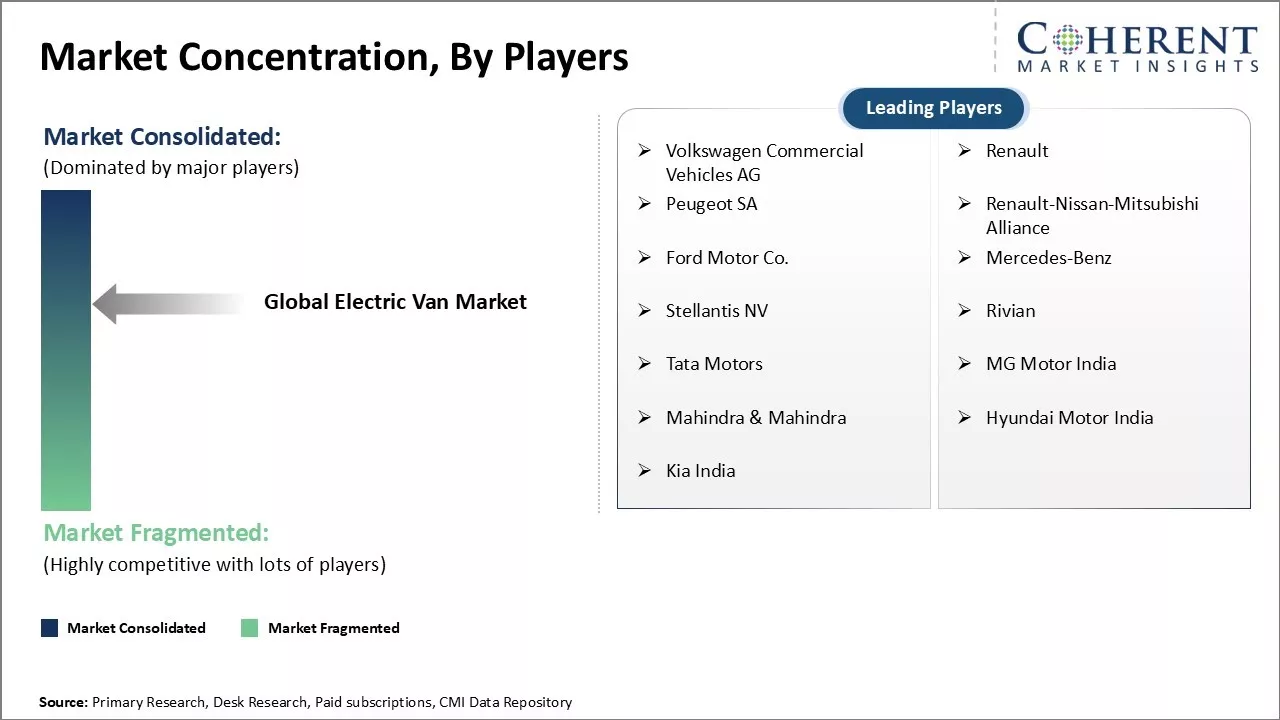Electric Van Market Size and Trends
Global electric van market is estimated to be valued at USD 32.78 Bn in 2025 and is expected to reach USD 58.06 Bn by 2032, exhibiting a compound annual growth rate (CAGR) of 8.5% from 2025 to 2032.

Discover market dynamics shaping the industry: Download Free Sample
Global Electric Van Market is driven by stringent emission norms and rising demand for fuel-efficient commercial vehicles across the globe. Several governments are providing subsidies to promote the adoption of electric commercial vehicles, which is supporting the market growth.
The electric van market is expected to witness significant growth driven by growing focus of commercial fleet owners on reducing operational costs and carbon footprint. Furthermore, technological advancements in battery technology and rising investment by leading automakers are expanding the electric van model offerings, making them more viable for commercial applications. This, coupled with expanding charging infrastructure, is anticipated to drive the electric van market.

Discover high revenue pocket segments and roadmap to it: Download Free Sample
Insights by Propulsion Type: The Future of Sustainable Mobility
In terms of propulsion type, fuel cell electric vehicle segment is estimated to hold the highest share of the market of 53.6% in 2025 owing to its potential for zero-emission transportation. Fuel cells convert hydrogen into electricity efficiently through an electrochemical reaction with oxygen from the air, powering electric motors while emitting only water vapor and warm air. With increasing concerns about climate change and air pollution, fuel cell electric vehicles (FCEVs) present a promising alternative to traditional gasoline and battery electric vehicles, offering faster refueling times and longer driving ranges.
Insights by Vehicle Type: Mobility for the Masses
In terms of vehicle type, commercial vehicles segment is estimated to hold the highest share of the market, accounting for 44.9% in 2025. Electric two-wheelers offer an affordable, efficient and low-maintenance option for short-distance commuting in dense urban areas across Asia and Europe. Battery-powered scooters and motorcycles offer virtually no operational costs compared to gasoline models, while producing zero direct emissions.
Insights by Speed: Accelerating Towards an Electric Future
In terms of speed, less than 100 MPH is expected to contribute the highest share of the market, accounting for 42.6% in 2025 as practical electric vehicles become optimized for daily commutes rather than racing capabilities. The majority of trips taken by personal vehicles worldwide are slower journeys to and from work, errands or school with average speeds usually well under 100mph.
Regional Insights

Need a Different Region or Segment? Download Free Sample
Regional Analysis: Global Electric Van Market
Dominating Region: North America
North America is expected to account for the greatest revenue share, with 39.1% in 2025 of leading OEMs like Ford and GM. Government initiatives promoting clean mobility and increasing adoption of electric vehicles have created a conducive market ecosystem. Large fleet operators in last-mile delivery segment are actively replacing their conventional vans with electric variants to reduce operational costs.
Fastest-Growing Region: Asia Pacific
Asia Pacific is expected to account for the greatest revenue share, with 39.1% in 2025. Meanwhile, the Asia Pacific region exhibits the fastest growth riding on the back of supportive policies and infrastructure development for EVs in major countries like China. The shared mobility boom and growing logistics industry are high impact sectors propelling electric commercial vehicle sales.
Electric Van Market Outlook for Key Regions
U.S.: The global electric van market in the U.S. is led by companies like Ford with its E-Transit model. Recent spending bills earmarking billions towards EV adoption are expected to fuel the transition.
China: The global electric van market in China continues to lead with the largest EV production capabilities. Startups like NIO have popularized battery swap models. Local governments provide purchase incentives for fleet operators.
Europe: Countries like Germany and the U.K. are focusing on zero-emissions zones in major cities driving fleet electrification. Daimler and Renault have strengthened product lineups catering to last-mile needs.
Japan: Japanese giants like Toyota are investing to expand their portfolio beyond passenger EVs. Recent partnerships between automakers and logistics companies will upscale electric commercial vehicle deployment.
Market Concentration and Competitive Landscape

Get actionable strategies to beat competition: Download Free Sample
Top Strategies Followed by Global Electric Van Market Players
Established Players:
Research and Development Investment: Leading companies like Ford and Mercedes extensively focus on research and development to continuously innovate and introduce high-performance electric van models. They invest heavily in battery technology to enhance vehicle range. Ford's recent unveiling of its E-Transit van highlights this approach.
Mid-Level Players:
Cost-Effective Solutions: Players like PSA and Fiat provide quality yet affordable electric vans to target price-sensitive commercial customers. Their electric vans are competitively priced without compromising features. This allows broader market penetration.
Small-Scale Players:
Niche Specialization: Small companies focus on specialized high-tech niches. For example, Arrival targets last-mile deliveries with modular bodies and self-driving capabilities. Its usage of low-cost materials allows competitive pricing. Another player Ekta focuses on small parcel and courier services with lightweight durable vans.
Emerging Startups in the Global Electric Van Market
Innovative Technologies:
Examples: Startups like Rivian (LiDAR technology) and Arrival (self-driving) are developing advanced solutions. Electric VanCo develops smart sensors and Internet of Things (IoT) platforms for fleet management.
Market/Impact: If successful, these technologies could revolutionize logistics operations, making deliveries safer and more efficient. This may boost electric van adoption rates.
Sustainable Solutions:
Examples: Starship Technologies aims to reduce emissions through autonomous deliveries. Another startup, BetterPlace, focuses on swappable battery technologies and recycling to lessen environmental impact.
Environmental Impact: Companies like these could play a key role in facilitating the transition to a low-carbon economy through innovations centered on sustainability and recycling.
Electric Van Industry News
In June 2024, Honda is a global automotive and motorcycle manufacturer known for innovation, reliability, and advanced engineering. launched an electric van, the N-VAN e, priced from US$15,550. This launch is a part of Honda's push for its broader decarbonization plan, which will be adopted in all the group's vehicles, making electric vehicles and fuel cell vehicles 40% of global sales by 2030.
In April 2024, Mercedes-Benz is a luxury automotive brand known for producing premium vehicles with cutting-edge technology and elegant design unveiled a luxury electric van, aimed at the Chinese market, based on its pioneering VAN-EA platform. "This new model is positioned as a super-luxury version," said a statement from Mercedes-Benz Vans. Mercedes-Benz is taking advantage of the strategy of deriving benefits from the increased demand for premium vans in China. This new model will be part of the bigger plan to increase its market share in the country.
In May 2023, Suzuki Motor Corporation (Suzuki), Toyota Motor Corporation (Toyota), and Daihatsu Motor Co., Ltd. announced that they will showcase a prototype Battery Electric Vehicle (BEV), an electric mini-commercial van-for which it will be the world's first model with a jointly developed BEV system
In November 2023, in a move that is bound to excite the market, an emerging EV car company, Rivian Automotive, Inc., announced that it will make its custom-designed Rivian Commercial Van available to purchase by any third-party organization. This will give firms all over the world additional opportunities to electrify their delivery fleets with leading-edge technology vehicles, further contributing towards reduced emissions of CO2.
In December 2022, DHL and General Motors inked a deal for electric delivery vans. The electric delivery van is used in last-mile delivery across the world, including over 2,000 electric delivery vans to be delivered worldwide by the end of 2023. The deal will also provide potential access to innovative products and exploration of Ford Pro digital and charging solutions.
Key Takeaways from Analyst
- Global electric van market is poised to witness significant growth over the coming years. Stringent emission norms across regions are prompting van fleet operators to transition towards electric options. Governments are also offering subsidies and tax benefits for commercial electric vehicles, fuelling adoption. However, higher acquisition costs remain a key restraint with total cost of ownership still being higher than conventional diesel vans. Europe continues to be the dominant market currently due to strong supportive policies. The EU has outlined plans to phase out petrol and diesel-powered commercial vehicles by 2040. Several large corporates in the U.K. and Germany have already committed to electrify their van fleets.
Market Report Scope
Electric Van Market Report Coverage
| Report Coverage | Details | ||
|---|---|---|---|
| Base Year: | 2024 | Market Size in 2025: | USD 32.78 Bn |
| Historical Data for: | 2020 To 2024 | Forecast Period: | 2025 To 2032 |
| Forecast Period 2025 to 2032 CAGR: | 8.5% | 2032 Value Projection: | USD 58.06 Bn |
| Geographies covered: |
|
||
| Segments covered: |
|
||
| Companies covered: |
Volkswagen Commercial Vehicles AG, Renault, Peugeot SA, Renault-Nissan-Mitsubishi Alliance, Ford Motor Co., Mercedes-Benz, Stellantis NV, Rivian, Tata Motors, MG Motor India, Mahindra & Mahindra, Hyundai Motor India, and Kia India |
||
| Growth Drivers: |
|
||
| Restraints & Challenges: |
|
||
Uncover macros and micros vetted on 75+ parameters: Get instant access to report
Market Dynamics
Market Driver - Increasing environmental concerns due to emissions from conventional vehicles
Global concerns regarding climate change have increased exponentially in recent years. The consensus within the scientific community is that human-induced emissions, especially from conventional vehicles that run on gasoline and diesel, are a major contributing factor in increasing atmospheric carbon levels and global warming. For instance, the U.K. government provided grants up to 20% of the purchase price for zero-emission capable vans until mid-2022 to drive EV adoption.
Market Challenge - High production costs of electric vehicles compared to conventional vehicles
One of the major challenges faced by the global electric van market is the higher production costs of electric vehicles compared to conventional gasoline or diesel-powered vans. The battery packs that power electric vehicles are still very expensive to produce at scale due to the high costs of battery cells and other components. According to the European Commission's Directorate-General for Climate Action, electric van sales in Europe in 2021 were around 50% lower than forecasts even with purchase subsidies in many countries averaging US$ 8,500-10,000 per vehicle.
Market Opportunity - Growth of e-commerce sector boosting demand for last-mile delivery vehicles
The rapidly growing e-commerce sector is opening significant opportunities for the adoption of electric vehicles for last-mile deliveries. With online retail sales rising at a double-digit pace year-on-year in many countries, the demand for last-mile delivery vehicles to ship packages to customers' doorsteps is increasing exponentially. This rising volume of packages handled by logistics and delivery fleets is boosting market requirements for more fuel-efficient and environment-friendly transportation solutions. According to the International Energy Agency, the average production costs of an electric van was approximately US$ 10,000-12,000 higher than a diesel van in 2021.
Market Segmentation
- Propulsion Type Insights (Revenue, USD, 2020 - 2032)
-
- Fuel Cell Electric Vehicle
- Plug-in Hybrid Electric Vehicle
- Battery Electric Vehicle
- Vehicle Type Insights (Revenue, USD, 2020 - 2032)
-
- Two-Wheelers
- Passenger Cars
- Commercial Vehicles
- Speed Insights (Revenue, USD, 2020 - 2032)
-
- Less Than 100 MPH
- 100 to 125 MPH
- More Than 125 MPH
- Regional Insights (Revenue, USD, 2020 - 2032)
- North America
- U.S.
- Canada
- Latin America
- Brazil
- Argentina
- Mexico
- Rest of Latin America
- Europe
- Germany
- U.K.
- Spain
- France
- Italy
- Russia
- Rest of Europe
- Asia Pacific
- China
- India
- Japan
- Australia
- South Korea
- ASEAN
- Rest of Asia Pacific
- Middle East
- GCC Countries
- Israel
- Rest of Middle East
- Africa
- South Africa
- North Africa
- Central Africa
- North America
- Key Players Insights
- Volkswagen Commercial Vehicles AG
- Renault
- Peugeot SA
- Renault-Nissan-Mitsubishi Alliance
- Ford Motor Co.
- Mercedes-Benz
- Stellantis NV
- Rivian
- Tata Motors
- MG Motor India
- Mahindra & Mahindra
- Hyundai Motor India
- Kia India
Share
Share
About Author
Gautam Mahajan is a Research Consultant with 5+ years of experience in market research and consulting. He excels in analyzing market engineering, market trends, competitive landscapes, and technological developments. He specializes in both primary and secondary research, as well as strategic consulting across diverse sectors.
Missing comfort of reading report in your local language? Find your preferred language :
Transform your Strategy with Exclusive Trending Reports :
Frequently Asked Questions
EXISTING CLIENTELE
Joining thousands of companies around the world committed to making the Excellent Business Solutions.
View All Our Clients
